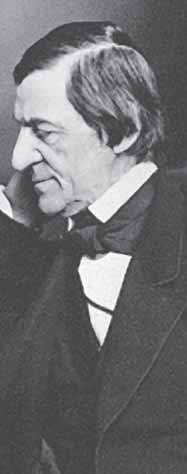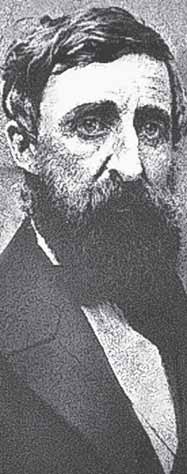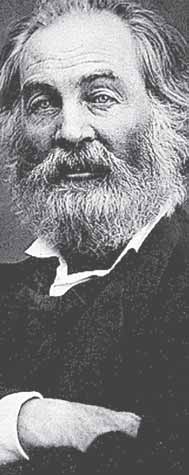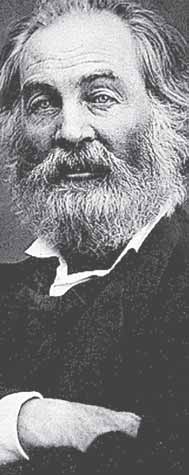westward migration as social back-
Cooper was a cultural relativist. He
ground. The novels bring to life
understood that no culture had a
frontier America from 1740 to 1804.
monopoly on virtue or refinement.
Cooper’s novels portray the suc-
Cooper accepted the American
cessive waves of the frontier set-
condition while Irving did not. Ir-
tlement: the original wilderness in-
ving addressed the American set-
habited by Indians; the arrival of the
ting as a European might have —
first whites as scouts, soldiers,
by importing and adapting Eu-
traders, and frontiersmen; the
ropean legends, culture, and histo-
coming of the poor, rough settler
ry. Cooper took the process a step
families; and the final arrival of the
farther. He created American set-
middle class, bringing the first pro-
tings and new, distinctively Amer-
fessionals — the judge, the physi-
ican characters and themes. He
cian, and the banker. Each incoming
was the first to sound the recurring
wave displaced the earlier: Whites
tragic note in American fiction.
displaced the Indians, who retreat-
ed westward; the “civilized” mid-
PHILLIS WHEATLEY
WOMEN AND MINORITIES
dle classes who erected schools,
lthough the colonial period
churches, and jails displaced the
produced several women
A
lower-class individualistic frontier
writers of note, the revolu-
folk, who moved further west, in
tionary era did not further the work
turn displacing the Indians who had
of women and minorities, despite
preceded them. Cooper evokes the
the many schools, magazines,
endless, inevitable wave of settlers,
newspapers, and literary clubs that
seeing not only the gains but the
were springing up. Colonial women
losses.
such as Anne Bradstreet, Anne
Cooper’s novels reveal a deep
Hutchinson, Ann Cotton, and Sarah
Engraving © The Bettmann
tension between the lone individual
Archive
Kemble Knight exerted consider-
24
able social and literary influence in spite of prim-
’Twas mercy brought me from my Pagan land
itive conditions and dangers; of the 18 women
Taught my benighted soul to understand
who came to America on the ship Mayflower in That there’s a God, that there’s a Savior too;
1620, only four survived the first year. When every Once I redemption neither sought nor knew.
able-bodied person counted and conditions were
Some view our sable race with scornful eye,
fluid, innate talent could find expression. But as
“Their colour is a diabolic dye.”
cultural institutions became formalized in the
Remember, Christians, negroes, black as Cain,
new republic, women and minorities gradually
May be refin’d, and join th’ angelic train.
were excluded from them.
Other Women Writers
Phillis Wheatley (c. 1753-1784)
A number of accomplished Revolutionary-era
Given the hardships of life in early America, it
women writers have been rediscovered by femi-
is ironic that some of the best poetry of the perinist scholars. Susanna Rowson (c. 1762-1824)
od was written by an exceptional slave woman.
was one of America’s first professional novelists.
The first African-American author of importance
Her seven novels included the best-selling
in the United States, Phillis Wheatley was born in seduction story Charlotte Temple (1791). She Africa and brought to Boston, Massachusetts,
treats feminist and abolitionist themes and
when she was about seven, where she was pur-
depicts American Indians with respect.
chased by the pious and wealthy tailor John
nother long-forgotten novelist was Hannah
Wheatley to be a companion for his wife. The
Foster (1758-1840), whose best-selling
A
Wheatleys recognized Phillis’s remarkable intel-
novel The Coquette (1797) was about a
ligence and, with the help of their daughter, Mary, young woman torn between virtue and tempta-Phillis learned to read and write.
tion. Rejected by her sweetheart, a cold man of
Wheatley’s poetic themes are religious, and
the church, she is seduced, abandoned, bears a
her style, like that of Philip Freneau, is neoclas-child, and dies alone.
sical. Among her best-known poems are “To S.M.,
Judith Sargent Murray (1751-1820) published
a Young African Painter, on Seeing His Works,” a
under a man’s name to secure serious attention
poem of praise and encouragement for another
for her works. Mercy Otis Warren (1728-1814)
talented black, and a short poem showing her
was a poet, historian, dramatist, satirist, and
strong religious sensitivity filtered through her
patriot. She held pre-Revolutionary gatherings in
experience of Christian conversion. This poem
her home, attacked the British in her racy plays,
unsettles some contemporary critics — whites
and wrote the only contemporary radical history
because they find it conventional, and blacks
of the American revolution.
because the poem does not protest the immoral-
Letters between women such as Mercy Otis
ity of slavery. Yet the work is a sincere expres-
Warren and Abigail Adams, and letters generally,
sion; it confronts white racism and asserts spiri-
are important documents of the period. For
tual equality. Indeed, Wheatley was the first to
example, Abigail Adams wrote to her husband,
address such issues confidently in verse, as in
John Adams (later the second president of
“On Being Brought from Africa to America”:
the United States), in 1776 urging that women’s
independence be guaranteed in the future U.S.
constitution.
■
25
The development of the self became a major
theme; self-awareness, a primary method. If,
CHAPTER according to Romantic theory, self and nature were one, self-awareness was not a selfish dead
end but a mode of knowledge opening up the uni-
3 verse. If one’s self were one with all humanity, then the individual had a moral duty to reform
THE ROMANTIC PERIOD,
social inequalities and relieve human suffer-
1820-1860:
ing. The idea of “self” — which suggested self-
ESSAYISTS AND POETS
ishness to earlier generations — was redefined.
New compound words with positive meanings
he Romantic movement, which originated
emerged: “self-realization,” “self-expression,”
in Germany but quickly spread to England,
“self-reliance.”
TFrance, and beyond, reached America As the unique, subjective self became impor-around the year 1820, some 20 years after William
tant, so did the realm of psychology. Exceptional
Wordsworth and Samuel Taylor Coleridge had
artistic effects and techniques were developed
revolutionized English poetry by publishing
to evoke heightened psychological states. The
Lyrical Ballads. In America as in Europe, fresh
“sublime” — an effect of beauty in grandeur
new vision electrified artistic and intellectual cir-
(for example, a view from a mountaintop) —
cles. Yet there was an important difference: Ro-
produced feelings of awe, reverence, vastness,
manticism in America coincided with the period
and a power beyond human comprehension.
of national expansion and the discovery of a dis-
Romanticism was affirmative and appropriate
tinctive American voice. The solidification of a
for most American poets and creative essayists.
national identity and the surging idealism and
America’s vast mountains, deserts, and tropics
passion of Romanticism nurtured the master-
embodied the sublime. The Romantic spirit
pieces of “the American Renaissance.”
seemed particularly suited to American democ-
Romantic ideas centered around art as inspira-
racy: It stressed individualism, affirmed the value tion, the spiritual and aesthetic dimension of
of the common person, and looked to the in-
nature, and metaphors of organic growth. Art,
spired imagination for its aesthetic and ethical
rather than science, Romantics argued, could
values. Certainly the New England Transcenden-
best express universal truth. The Romantics
talists — Ralph Waldo Emerson, Henry David
underscored the importance of expressive art
Thoreau, and their associates — were inspired
for the individual and society. In his essay “The
to a new optimistic affirmation by the Romantic
Poet” (1844), Ralph Waldo Emerson, perhaps the
movement. In New England, Romanticism fell
most influential writer of the Romantic era,
upon fertile soil.
asserts:
TRANSCENDENTALISM
For all men live by truth, and stand in need
The Transcendentalist movement was a reac-
of expression. In love, in art, in avarice, in
tion against 18th-century rationalism and a mani-
politics, in labor, in games, we study to utter
festation of the general humanitarian trend of
our painful secret. The man is only half him-
19th-century thought. The movement was based
self, the other half is his expression.
on a fundamental belief in the unity of the world
and God. The soul of each individual was thought
26

to be identical with the world — a
ed with the town, but the locale also
microcosm of the world itself. The
attracted the novelist Nathaniel
doctrine of self-reliance and indi-
Hawthorne, the feminist writer
vidualism developed through the
Margaret Fuller, the educator (and
belief in the identification of the
father of novelist Louisa May Al-
individual soul with God.
cott) Bronson Alcott, and the poet
Transcendentalism was intimate-
William Ellery Channing. The Tran-
ly connected with Concord, a small
scendental Club was loosely orga-
New England village 32 kilometers
nized in 1836 and included, at vari-
west of Boston. Concord was the
ous times, Emerson, Thoreau,
first inland settlement of the origi-
Fuller, Channing, Bronson Alcott,
nal Massachusetts Bay Colony.
Orestes Brownson (a leading min-
Surrounded by forest, it was and
ister), Theodore Parker (abolition-
remains a peaceful town close
ist and minister), and others.
enough to Boston’s lectures, book-
The Transcendentalists published
stores, and colleges to be intense-
a quarterly magazine, The Dial,
ly cultivated, but far enough away to
which lasted four years and was
be serene. Concord was the site
first edited by Margaret Fuller and
of the first battle of the Ameri-
later by Emerson. Reform efforts
can Revolution, and Ralph Waldo
engaged them as well as literature.
Emerson’s poem commemorating
A number of Transcendentalists
the battle, “Concord Hymn,” has
were abolitionists, and some were
one of the most famous opening
involved in experimental utopian
stanzas in American literature:
communities such as nearby Brook
Farm (described in Hawthorne’s
By the rude bridge that arched
The Blithedale Romance) and
the flood
Fruitlands.
Their flag to April’s breeze
Unlike many European groups,
unfurled,
the Transcendentalists never is-
Here once the embattled farmers
sued a manifesto. They insisted on
stood
individual differences — on the
And fired the shot heard round
RALPH
unique viewpoint of the individual.
the world.
WALDO EMERSON
American Transcendental Romantics
Concord was the first rural ar-
pushed radical individualism to the
tist’s colony, and the first place to
extreme. American writers often
offer a spiritual and cultural alter-
saw themselves as lonely explorers
native to American materialism. It
outside society and convention.
was a place of high-minded conver-
The American hero — like Herman
sation and simple living (Emerson
Melville’s Captain Ahab, or Mark
and Henry David Thoreau both had
Twain’s Huck Finn, or Edgar Allan
vegetable gardens). Emerson, who
Poe’s Arthur Gordon Pym — typi-
moved to Concord in 1834, and
Photo courtesy
cally faced risk, or even certain
National Portrait Gallery,
Thoreau are most closely associat-
Smithsonian Institution
destruction, in the pursuit of meta-
27
physical self-discovery. For the Romantic
also enjoy an original relation to the uni-
American writer, nothing was a given. Literary
verse? Why should not we have a poetry of
and social conventions, far from being helpful,
insight and not of tradition, and a religion by
were dangerous. There was tremendous pres-
revelation to us, and not the history of
sure to discover an authentic literary form, con-
theirs. Embosomed for a season in nature,
tent, and voice — all at the same time. It is clear whose floods of life stream around and
from the many masterpieces produced in the
through us, and invite us by the powers they
three decades before the U.S. Civil War (1861-
supply, to action proportioned to nature, why
65) that American writers rose to the challenge.
should we grope among the dry bones of the
past...? The sun shines today also. There is
Ralph Waldo Emerson (1803-1882)
more wool and flax in the fields. There are
Ralph Waldo Emerson, the towering figure of
new lands, new men, new thoughts. Let
his era, had a religious sense of mission.
us demand our own works and laws and
Although many accused him of subverting
worship.
Christianity, he explained that, for him “to be
a good minister, it was necessary to leave the
Emerson loved the aphoristic genius of the
church.” The address he delivered in 1838 at his
16th-century French essayist Montaigne, and he
alma mater, the Harvard Divinity School, made
once told Bronson Alcott that he wanted to write
him unwelcome at Harvard for 30 years. In it,
a book like Montaigne’s, “full of fun, poetry, busi-Emerson accused the church of acting “as if God
ness, divinity, philosophy, anecdotes, smut.” He
were dead” and of emphasizing dogma while sti-
complained that Alcott’s abstract style omitted
fling the spirit.
“the light that shines on a man’s hat, in a child’s merson’s philosophy has been called con-spoon.”
tradictory, and it is true that he conscious-
Spiritual vision and practical, aphoristic ex-
Ely avoided building a logical intellectual pression make Emerson exhilarating; one of the system because such a rational system would
Concord Transcendentalists aptly compared lis-
have negated his Romantic belief in intuition and
tening to him with “going to heaven in a swing.”
flexibility. In his essay “Self-Reliance,” Emerson Much of his spiritual insight comes from his
remarks: “A foolish consistency is the hobgoblin
readings in Eastern religion, especially Hin-
of little minds.” Yet he is remarkably consistent
duism, Confucianism, and Islamic Sufism. For
in his call for the birth of American individualism example, his poem “Brahma” relies on Hindu
inspired by nature. Most of his major ideas —
sources to assert a cosmic order beyond the lim-
the need for a new national vision, the use of
ited perception of mortals:
personal experience, the notion of the cosmic
Over-Soul, and the doctrine of compensation —
If the red slayer think he slay
are suggested in his first publication, Nature Or the slain think he is slain,
(1836). This essay opens:
They know not well the subtle ways
I keep, and pass, and turn again.
Our age is retrospective. It builds the sepul-
chres of the fathers. It writes biographies,
Far or forgot to me is near
histories, criticism. The foregoing genera-
Shadow and sunlight are the same;
tions beheld God and nature face to face;
The vanished gods to me appear;
we, through their eyes. Why should not we
And one to me are shame and fame.
28

They reckon ill who leave me out;
Emerson, he worked his way
When me they fly, I am the wings;
through Harvard. Throughout his
I am the doubter and the doubt,
life, he reduced his needs to the
And I the hymn the Brahmin sings
simplest level and managed to live
on very little money, thus maintain-
The strong gods pine for my
ing his independence. In essence,
abode,
he made living his career. A noncon-
And pine in vain the sacred Seven,
formist, he attempted to live his life
But thou, meek lover of the good!
at all times according to his rigor-
Find me, and turn thy back on
ous principles. This attempt was
heaven.
the subject of many of his writings.
Thoreau’s masterpiece, Walden,
This poem, published in the first
or, Life in the Woods (1854), is the
number of the Atlantic Monthly
result of two years, two months, and
magazine (1857), confused readers
two days (from 1845 to 1847) he
unfamiliar with Brahma, the high-
spent living in a cabin he built at
est Hindu god, the eternal and infi-
Walden Pond on property owned by
nite soul of the universe. Emerson
Emerson. In Walden, Thoreau con-
had this advice for his readers:
sciously shapes this time into one
“Tell them to say Jehovah instead
year, and the book is carefully con-
of Brahma.”
structed so the seasons are subtly
The British critic Matthew Arnold
evoked in order. The book also
said the most important writings in
is organized so that the simplest
English in the 19th century had
earthly concerns come first (in the
been Wordsworth’s poems and
section called “Economy,” he des-
Emerson’s essays. A great prose-
cribes the expenses of building a
poet, Emerson influenced a long
cabin); by the ending, the book
line of American poets, including
has progressed to meditations on
Walt Whitman, Emily Dickinson,
the stars.
Edwin Arlington Robinson, Wallace
In Walden, Thoreau, a lover of
Stevens, Hart Crane, and Robert
travel books and the author of sev-
Frost. He is also credited with HENRY DAVID THOREAU eral, gives us an anti-travel book influencing the philosophies of
that paradoxically opens the inner
John Dewey, George Santayana,
frontier of self-discovery as no
Friedrich Nietzsche, and William
American book had up to this time.
James.
As deceptively modest as Thoreau’s
ascetic life, it is no less than a guide
Henry David Thoreau
to living the classical ideal of the
(1817-1862)
good life. Both poetry and philoso-
Henry David Thoreau, of French
phy, this long poetic essay chal-
and Scottish descent, was born in
lenges the reader to examine his or
Concord and made it his perma-
her life and live it authentically. The
Photo © The Bettmann
nent home. From a poor family, like
Archive
building of the cabin, described in
29


great detail, is a concrete metaphor
wood, her wildman a Robin
for the careful building of a soul. In
Hood. There is plenty of genial
his journal for January 30, 1852,
love of nature in her poets, but
Thoreau explains his preference
not so much of nature herself.
for living rooted in one place: “I am
Her chronicles inform us when
afraid to travel much or to famous
her wild animals, but not
places, lest it might completely dis-
the wildman in her, became
sipate the mind.”
extinct. There was need of
Thoreau’s method of retreat and
America.
concentration resembles Asian
meditation techniques. The resem-
Walden inspired William Butler
blance is not accidental: like
Yeats, a passionate Irish national-
Emerson and Whitman, he was
ist, to write “The Lake Isle of
influenced by Hindu and Buddhist
Innisfree,” while Thoreau’s essay
philosophy. His most treasured
“Civil Disobedience,” with its theo-
possession was his library of Asian
ry of passive resistance based on
classics, which he shared with
the moral necessity for the just
Emerson. His eclectic style draws
individual to disobey unjust laws,
on Greek and Latin classics and
was an inspiration for Mahat-
is crystalline, punning, and as rich-
ma Gandhi’s Indian independence
ly metaphorical as the English
movement and Martin Luther King’s
metaphysical writers of the late
struggle for black Americans’ civil
Renaissance.
rights in the 20th century.
In Walden, Thoreau not only tests
Thoreau is the most attractive
the theories of Transcendental-
of the Transcendentalists today
ism, he re-enacts the collective
because of his ecological con-
American experience of the 19th
sciousness, do-it-yourself indepen-
century: living on the frontier.
dence, ethical commitment to abo-
Thoreau felt that his co







